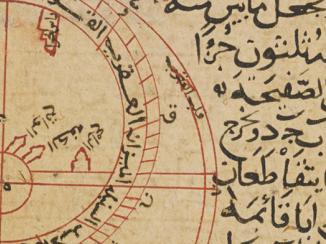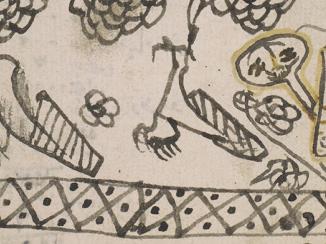al-Qānūn fī al-ṭibb القانون في الطبّ Avicenna ابن سينا
Or 4946
564 items in this record
Search within this record
The record is made up of Codex A collection of pages, usually gathered into quires, and bound between covers. ; ff. ii+274+ii. It was created in 13th century. It was written in Arabic. The original is part of the British Library: Oriental Manuscripts.
About this record
- Content
The Canon of Medicine (القانون في الطبّ) by Abū ‘Alī al-Ḥusayn ibn ‘Abd Allāh (أبو علي الحسين بن عبد الله), known as Ibn Sīnā (ابن سينا, latinised as Avicenna, 980-1037).
An unsigned note, without date, in the upper margin of f. 1r states that the physycian Ibn al-Nafīs (ابن النفيس, d. 1288), here referred to by his full name Abū al-Hasan ‘Alā’ al-Dīn ‘Alī ibn Abī al-Ḥazm al-Qurashī (أبو الحسن علاء الدين علي بن أبي الحزم الشهير بالقرشي), claimed that this copy was produced by Avicenna himself.
Begins (f. 1v, lines 1-3):
... وبعد فقد التمس
مني بعض خلص إخواني ومن يلزمني إسعافه فيما يسمح به وسعي أن أضف في الطب كتابًا مشتملًا على قوانينه الكلية والجزؤية اشتمالًا يجمع إلى الشرح الاختصار
وإلى ايفا الأكثر حقه من البيان
Ends (f. 274r, line 9):
الثلث أوثولات سبع قراريط المواثوس أوقية ونصف المواثوسين ثلث أواق ثمنه أوثولو أربعة وغرمي قيراطان
Colophon Section at the end of a manuscript text. (f. 274r, line 10):
تم كتاب القانون في علم الطب
after these words another hand writing with another ink writes
على يد مؤلفه
- Extent and format
- Codex A collection of pages, usually gathered into quires, and bound between covers. ; ff. ii+274+ii
- Physical characteristics
Material: Eastern laid paper
Dimensions: 325 x 215 mm leaf [290 x 185 mm written]
Foliation: Eastern Arabic foliation in black ink at centre of upper margin, British Museum foliation in pencil
Ruling: Misṭarah ; 48 lines per page; vertical spacing 17 lines per 10 cm
Script: Naskh
Ink: Black ink, with rubricated headings and occasional overlinings in red
Decoration: Illuminated frontispiece in Mamluk style in gold, blue, red and green (f. 1r), illuminated panel below colophon Section at the end of a manuscript text. in similar style and colours (f. 274r)
Binding: Ottoman red leather binding with flap, gold-tooled borders medallion and pendants, marbled paper doublure and and first flyleaves at front and end
Condition: Waterstains, wormholes, a quire Collection of papers folded in half and stitched together to form a gathering of folios. (quinion) has been lost from the original manuscript and replaced (ff. 192-201)
Marginalia: Very few
Seals: ff. 1r, 25r, 92r, 169r, 214r, and 274r
- Written in
- Arabic in Arabic script
- Type
- Manuscript
Archive information for this record
- Original held at
- British Library: Oriental Manuscripts
- Access conditions
Unrestricted
- Archive reference
- Or 4946
- Date(s)
- 13th century (CE, Gregorian)
- Provenance
- Aḥmad ibn Ḥusayn al-mutaṭabbib (أحمد بن حسين المتطبب): his inscription, dated 1034/1624-5 (f. 1r);
- ‘Alī ibn ‘Abd al-Majīd al-ṭabīb (علي بن عبد المجيد الطبيب): his inscription, without date (f. 1r);
- Aḥmad ibn al-‘Aṭṭār Aḥmad (أحمد بن العطار أحمد): his inscription, defaced, dated 866/1461-2 (f. 1r);
- Muḥammad ibn Yūsuf ibn Yūsuf al-Shāfi‘ī (محمد بن يوسف بن يوسف الشافعي): his inscription, defaced (f. 1r);
- al-Ḥājī Bashīr (الحجي بشير), Ottoman Kizlar Ağası or Chief Harem Eunuch (أغاء دار السعادة, served 1717-46; see Hathaway, Beshir Agha: Chief Eunuch of the Ottoman Imperial Harem [Oxford: Oneworld, 2005]): his seals (the larger dated 1130/1717-18 [Chester Beatty Library Islamic Seals Database no. 465], and the smaller without date [Chester Beatty Library Islamic Seals Database no. 464]), and inscription, dated 1158/1745-6 (f. 1r; the seals appear again on ff. 25r, 92r, 169r, 214r, and 274r);
- Muḥammad Amīn (محمد أمين), Inspector of Endowments at Mecca and Medina (مفتش أوقاف الحرمين المحرمين): His seal, without date (see Chester Beatty Library Islamic Seals Database no. 385), and inscription, without date, stating that this manuscript was endowed (وقف) by al-Ḥājī Bashīr (الحجي بشير), Ottoman Kizlar Ağası or Chief Harem Eunuch (أغاء دار السعادة, tenure 1717-46) (f. 1r);
- Maḥmūd ibn Mas‘ūd ibn ‘Alī al-ṭabīb (محمود بن مسعود بن علي الطبيب): his inscription, without date, below which is an unsigned note by another hand, claiming that the note above was by the hand of the astronomer and physician of Samarqand Quṭb al-Dīn Maḥmūd ibn Mas‘ūd al-Shīrāzī (قطب الدين محمود بن مسعود الشيرازي, d. 1310) (f. 274r).
- Finding aids
- Ellis, A.G. and Edward Edwards, A Descriptive List of the Arabic Manuscripts Acquired by the Trustees of the British Museum since 1894 (London: British Museum, 1912), p. 43
- Hamarneh, Sami, Catalogue of Arabic Manuscripts on Medicine and Pharmacy at the British Library (Cairo: Les Editions Universitaires d’Egypte, 1975), Item 98, pp. 99-101
- Select Bibliography
Edition:
- Ibn Sīnā, Abū ʻAlī al-Ḥusayn ibn ʻAlī, al-Qānūn fī al-ṭibb , ed. by Idwār al-Qashsh, 2nd edition, 4 vols (Bayrūt: Muʾassasat ʻIzz al-Dīn, 1993)
Study:
- Hathaway, Jane, Beshir Agha: Chief Eunuch of the Ottoman Imperial Harem (Oxford: Oneworld, 2005)
Access & Reference
History of this record
Related material
Related search terms
- Subjects
- Medicine--Early works to 1800
- People & organisations
- AvicennaMaḥmūd ibn Mas'ūd Quṭb al-Dīn al-Shīrāzī
Use and share this record
- Share this record
- Cite this record in your research
al-Qānūn fī al-ṭibb القانون في الطبّ Avicenna ابن سينا, British Library: Oriental Manuscripts, Or 4946, in Qatar Digital Library <https://www.qdl.qa/archive/81055/vdc_100041536079.0x000001> [accessed 27 July 2024]
- Link to this record
https://www.qdl.qa/en/archive/81055/vdc_100041536079.0x000001
- IIIF details
This record has a IIIF manifest available as follows. If you have a compatible viewer you can drag the icon to load it.https://www.qdl.qa/en/iiif/81055/vdc_100041536079.0x000001/manifestOpen in Universal viewerOpen in Mirador viewerMore options for embedding images
Copyright: How to use this content
- Reference
- Or 4946
- Title
- al-Qānūn fī al-ṭibb القانون في الطبّ Avicenna ابن سينا
- Pages
- front, back, spine, edge, head, tail, front-i, i-r:ii-v, 1r:274v, iii-r:iv-v, back-i
- Author
- Please see item description
- Usage terms
- Public Domain





















































































































































































































































































































































































































































































































































































